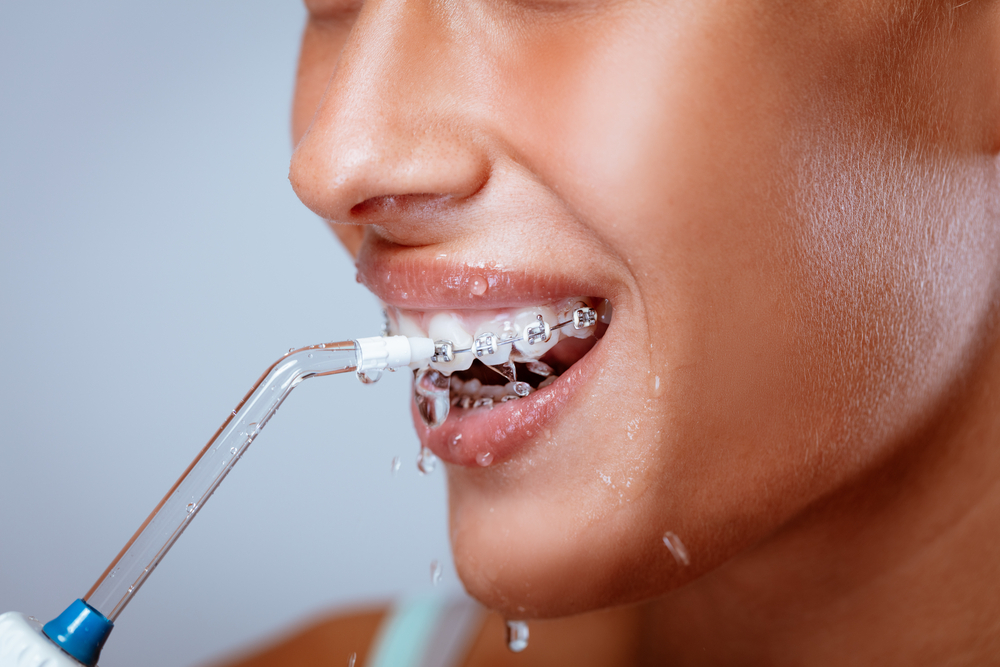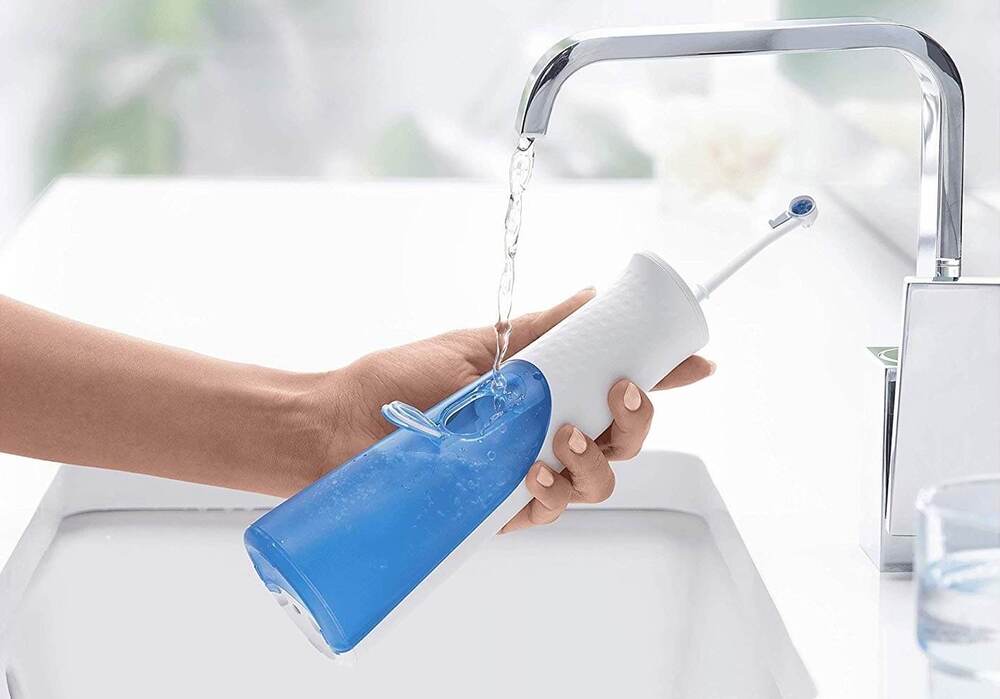
Did Your Dentist Recommend a Dental Water Jet? Here’s Why You Should Listen
What Is A Dental Water Jet?
A dental water jet, also known as a dental irrigator or water flosser, is a device designed to enhance oral hygiene by using a stream of pulsating water to remove food particles and plaque. It reaches areas between teeth and below the gumline that traditional brushing and flossing might miss.
This article explores why dentists recommend incorporating dental water jets into your oral care routine. From understanding their technology to comparing them with traditional flossing methods, we’ll delve into how these devices can benefit your dental health.
Understanding Dental Water Jets
A dental water jet, often referred to as a dental irrigator, water flosser, or oral irrigator, is a device designed to enhance oral hygiene. These devices utilize a stream of pulsating water to dislodge food particles and plaque from between teeth and below the gumline.
How Dental Water Jets Work
Dental water jets operate by emitting a high-pressure, pulsating stream of water. This stream effectively reaches areas that traditional floss might miss. The technology behind these devices varies but typically involves:
- Pulsating Water Stream: Creates tiny bursts of water that help in loosening and removing debris.
- Adjustable Pressure Settings: Allow users to customize the intensity based on their comfort and specific needs.
- Specialized Tips: Different tips for various uses such as orthodontic tips for braces, plaque seeker tips for implants, and periodontal tips for deep cleaning.
Differences Between Traditional Flossing and Dental Water Jets
Traditional flossing methods, like string floss, are widely recommended for their ability to scrape plaque off the tooth surface. However, dental water jets offer several unique advantages:
Accessibility:
- Effective at reaching tight spots between teeth and below the gumline.
- Particularly beneficial for individuals with braces, implants, or periodontal pockets.
Ease of Use:
- Less manual dexterity required compared to string floss.
- Suitable for those who find traditional flossing challenging due to arthritis or other conditions affecting hand mobility.
Gentle on Gums:
- The pulsating water stream is generally gentler on gums compared to the scraping action of floss.
Thorough Cleaning:
- While traditional floss scrapes plaque off the tooth surface, dental water jets wash away food particles and bacteria more effectively in certain areas.
Understanding these distinctions helps clarify why your dentist might recommend incorporating a dental irrigator into your oral care routine.

The Mechanism Behind Dental Water Jet
Technology Used in Dental Water Jets
Dental water jets use pulsating water streams to effectively clean teeth and gums. This technology creates rapid bursts of water that can reach areas traditional floss might miss. The pulsating action helps dislodge food particles and plaque stuck between teeth and along the gumline.
Effectiveness in Removing Food Particles and Plaque
Water jets are excellent at removing food debris and plaque from the mouth. The pulsating water streamtargets hard-to-reach areas, flushing out particles that could lead to cavities or gum disease. Studies have shown that using one can significantly reduce plaque buildup and improve overall gum health.
Benefits for Individuals with Braces or Implants
For those with braces or dental implants, maintaining oral hygiene can be challenging. Dental water jets offer several advantages:
- Braces: Traditional flossing around braces is time-consuming and often ineffective. The pulsating water stream of a dental jet easily navigates around brackets and wires, ensuring thorough cleaning.
- Implants: Dental implants require meticulous care to prevent infections around the implant site. A dental water jet can clean below the gumline without putting pressure on the implant itself, reducing the risk of peri-implantitis.
Utilizing advanced pulsating water stream technology, dental water jets provide an efficient way to remove plaque and food particles, especially benefiting individuals with braces or implants. This method ensures comprehensive cleaning where traditional floss may fall short.
Benefits of Using a Dental Water Jet for Oral Health
Promoting Gum Health and Reducing Risks of Gum Diseases
Scientific studies have repeatedly shown that dental irrigators significantly contribute to gum health. Gingivitis reduction is one of the primary benefits. For instance, a study published in the Journal of Clinical Dentistry found that individuals using a dental water jet experienced a 51% greater reduction in gingivitis than those who used traditional string floss.
In addition to combating gingivitis, dental water jets also play a crucial role in the prevention and management of periodontal disease. The pulsating water stream not only dislodges food particles but also cleanses below the gumline, reducing harmful bacteria. This is particularly beneficial for individuals with periodontal pockets, where bacteria can easily accumulate and lead to severe gum issues.
Advantages for Specific Oral Conditions
People with specific oral conditions like periodontal pockets or those wearing orthodontic appliances can benefit immensely from using a dental water jet. Traditional flossing methods might struggle to reach these intricate areas effectively.
- Periodontal Pockets: Dental water jets can clean deep within these pockets, flushing out bacteria and debris that traditional methods might miss. This reduces inflammation and helps maintain healthier gums.
- Orthodontic Appliances: Braces and retainers create additional challenges for maintaining oral hygiene. The targeted stream from a dental water jet can navigate around brackets and wires, ensuring thorough cleaning without causing damage or discomfort.
The ease of use makes it an attractive option for those who find manual flossing challenging due to limited dexterity or other issues. By incorporating a dental water jet into their daily routine, individuals can achieve better overall oral health with less effort.
Using a dental water jet complements traditional brushing routines by providing an extra layer of cleanliness that reaches places brushes and floss can’t always access efficiently.
Comparing Dental Water Jets with Traditional Flossing Methods
Using a dental water jet versus traditional flossing methods like string floss presents distinct advantages and disadvantages.
Pros of Dental Water Jets:
- Ease of Use: Dental water jets are generally easier to handle, especially for individuals with limited manual dexterity or arthritis.
- Effective Cleaning: They efficiently remove debris from hard-to-reach areas, such as around braces, implants, and periodontal pockets.
- Gentle on Gums: The pulsating water stream is less likely to cause gum irritation or bleeding compared to traditional string floss.
Cons of Dental Water Jets:
- Cost: Dental water jets are typically more expensive than traditional floss.
- Bulkiness: They require storage space and may not be as portable.
- Maintenance: Regular cleaning and maintenance are necessary to ensure the device functions properly.
Pros of Traditional Flossing
- Thorough Plaque Removal: String floss can be very effective in scraping away plaque from the surfaces between teeth.
- Affordable: Traditional floss is inexpensive and widely accessible.
- Portability: It’s easy to carry a small container of floss anywhere.
Cons of Traditional Flossing
- Manual Dexterity Required: Individuals with limited manual dexterity may find it challenging to use string floss effectively.
- Gum Irritation: Improper technique can lead to gum irritation or bleeding.

User-Friendliness Concerns
For those who struggle with the fine motor skills required for traditional flossing, dental water jets offer a user-friendly alternative. The ease of use provided by dental water jets makes them particularly appealing for children, elderly individuals, and those with disabilities. With just the press of a button, users can achieve a thorough clean without the need for intricate hand movements, making oral hygiene more accessible for everyone.
Considerations When Choosing a Dental Water Jet
Selecting the right device involves weighing several factors to determine if it fits your lifestyle and oral care needs. While these devices offer many benefits, they also come with some common disadvantages worth considering:
- Higher Cost: Dental water jets typically cost more than traditional flossers. The initial investment can range from $30 to over $100, depending on the brand and features. Replacement tips and accessories can also add to the ongoing expense.
- Bulkier Size: Unlike a small spool of dental floss, water jets are bulkier and less portable. They often require countertop space in your bathroom and access to an electrical outlet, which might be inconvenient for small or shared spaces.
Maintenance Requirements
To ensure optimal performance and longevity of your dental water jet, regular cleaning and maintenance are crucial.
- Regular Cleaning: Bacteria can build up in the water reservoir and internal components if not cleaned properly. It’s recommended to empty and dry the reservoir after each use and periodically clean it with a mixture of vinegar or mild bleach solution.
- Replacing Tips: Similar to replacing a toothbrush, the tips of dental water jets need regular replacement—typically every 3-6 months. This ensures that the jet continues to function effectively and hygienically.
Adhering to these maintenance requirements helps maximize the device’s effectiveness in maintaining oral hygiene. By understanding these considerations, you can make a more informed decision when choosing a device that aligns with your specific needs.
Using a Dental Water Jet Effectively: Tips and Recommendations
Proper usage of a dental water jet ensures maximum benefits for your oral health. Here are some practical guidelines:
Usage Instructions
- Fill the Reservoir: Start by filling the water reservoir with lukewarm water. You can also add a mouthwash if recommended by your dentist.
- Select the Tip: Attach the appropriate tip to your device. Most dental water jets come with various tips designed for different needs, such as orthodontic tips for braces or plaque seeker tips for implants.
- Adjust Pressure Settings: Choose a comfortable pressure setting. Beginners may want to start with a lower setting and gradually increase it as they get accustomed to the sensation.
- Lean Over the Sink: Lean over the sink to avoid splashing water everywhere. Keep your mouth slightly open to let water flow out.
- Aim and Clean: Direct the tip at a 90-degree angle to your gumline and move it along your teeth, pausing briefly between each tooth. Focus on both the front and back sides.
Recommended Frequency and Duration
- Frequency: Use your dental water jet once daily for optimal results.
- Duration: Spend about 60 seconds cleaning your entire mouth, ensuring you cover all areas.
Integrating Into Daily Routines
Finding a suitable time in your daily routine can make using a dental water jet more convenient:
- After Brushing Teeth: This allows you to remove any remaining particles and ensures a thorough clean.
- Before Bedtime: Using it before bed helps eliminate food debris accumulated throughout the day, reducing overnight bacterial growth.
By following these guidelines, incorporating a dental water jet into your oral care routine becomes straightforward and effective. Proper usage enhances its benefits, contributing significantly to maintaining excellent oral hygiene.
Exploring Popular Brands and Models of Dental Water Jets in 2024
Choosing the right dental water jet can be daunting with so many options available. Here are a few well-known brands that have established themselves as leaders in the market:
Waterpik
Waterpik is often considered the gold standard in dental water jets. Known for its innovative technology and reliable performance, it offers various models to suit different needs. Features like multiple pressure settings and interchangeable tips make it versatile and user-friendly.
OralB AquaCare4
The OralB AquaCare4 is another popular choice. It boasts cutting-edge features such as on-demand button control, which allows users to precisely manage water flow. Its compact design makes it easy to handle, especially for those new to using dental water jets.
Philips SoniCare Airfloss
For a different approach, consider the Philips SoniCare Airfloss. This model uses microburst technology to deliver powerful bursts of air and water, effectively cleaning between teeth. It’s particularly praised for its ease of use and quick cleaning cycles.
These brands offer distinct advantages, whether you prioritize advanced features, ease of use, or compact design. Each has been designed with user satisfaction and oral health in mind, providing excellent choices for maintaining optimal dental hygiene.
Debunking Common Myths Surrounding Dental Water Jets Vs. Traditional Methods
Misconceptions about flossing vs. water jets are common and deserve clarification. One prevalent myth is that dental water jets are less effective than traditional floss. In reality, both methods serve unique purposes and can be complementary.
Effectiveness
Many believe that water jets can’t remove plaque as effectively as string floss. However, studies suggest that water jets are highly effective in reducing gingivitis and cleaning hard-to-reach areas, especially for individuals with braces or implants.
Gentleness
Another misconception is that string floss is gentler on gums compared to the powerful stream of water. In fact, dental water jets can be gentler because they minimize the risk of cutting or damaging gum tissues, which can occur with improper string flossing techniques.
Ease of Use
Some think traditional floss is easier to use than a dental water jet. For people with limited dexterity or arthritis, water jets can be significantly easier to handle, offering a more accessible option for maintaining oral hygiene.
It’s crucial to understand that each method has its strengths and limitations. Dental professionals often recommend combining both methods for optimal results tailored to individual needs.
Expert Opinions on Incorporating Dental Water Jets Into Your Daily Routine
Dentists and dental organizations provide valuable insights on the role of dental water jets in maintaining oral health. The American Dental Association (ADA) acknowledges the benefits of dental irrigators, especially for individuals with specific dental needs.
ADA Recommendations:
- Effective Supplement: The ADA suggests that while dental water jets can be an effective supplement to traditional flossing, they should not entirely replace it. Water jets help remove food particles and reduce gingivitis, but traditional flossing is still crucial for thorough plaque removal.
- Ease of Use: For people with braces, implants, or limited dexterity, the ADA highlights that water flossers can offer an easier and more comfortable way to maintain oral hygiene. The pulsating water stream can reach areas that string floss might miss.
- Gum Health: Studies backed by the ADA indicate that using a dental irrigator can promote gum health and reduce the risk of periodontal disease.
Expert Tips:
- Integrate with Brushing: Dental professionals recommend using a water jet after brushing to maximize cleaning efficiency.
- Daily Routine: Consistency is key. Incorporating a dental water jet into your daily routine ensures better oral hygiene over time.
Understanding these expert opinions helps you make informed decisions about including a dental water jet in your oral care regimen.
Making an Informed Decision About Your Oral Care Tools
Choosing the right tools for your oral hygiene routine is a crucial step towards maintaining a healthy smile. Consulting with your dentist can provide personalized advice tailored to your specific needs, helping you decide if a dental water jet is the right addition to your regimen.
Remember, FineUp Clinic is here to support you in achieving optimal oral health. For more information on maintaining excellent oral hygiene practices, visit FineUp Clinic.
- Speak with your dentist about whether a dental water jet suits your specific oral health needs.
- Explore FineUp Clinic’s website for expert tips and resources on oral care.
Taking these steps ensures that you are making an informed decision, setting you on the path to a healthier smile.
FAQs (Frequently Asked Questions)
What is a dental water jet and how does it contribute to oral hygiene?
A dental water jet, also known as a dental irrigator or oral irrigator, is a device that uses a pulsating stream of water to remove food particles and plaque from teeth and gums. It plays a significant role in maintaining oral hygiene by effectively cleaning areas that traditional flossing may miss.
How do dental water jets work compared to traditional flossing methods?
Dental water jets use technology that delivers a targeted pulsating water stream to clean between teeth and along the gumline. Unlike traditional flossing, which relies on manual dexterity to maneuver string floss, dental water jets can be easier to use for individuals with limited mobility or those who find string floss challenging.
What are the benefits of using a dental water jet for individuals with braces or implants?
These devices are particularly beneficial for individuals with braces or implants as they effectively remove food particles and plaque from hard-to-reach areas. This helps maintain gum health and reduces the risk of gum disease, especially in patients with orthodontic appliances or periodontal pockets.
Are there any disadvantages to using dental water jets compared to traditional flossing?
Yes, some disadvantages include the higher cost of water jets compared to traditional flossers and their bulkier size, which may make them less portable. Additionally, regular maintenance is required to ensure optimal performance and longevity of the device.
What recommendations do experts have for integrating dental water jets into daily oral care routines?
Experts recommend using a dental water jet as part of your overall oral care routine by incorporating it after brushing teeth or before bedtime. It is suggested to use the device regularly, following specific usage instructions regarding frequency and duration for best results.
What should I consider when choosing a dental water jet?
When selecting a dental water jet, consider factors such as maintenance requirements, cost comparison with traditional flossers, and user-friendliness. It’s also important to evaluate the effectiveness of different models based on your specific oral health needs.
